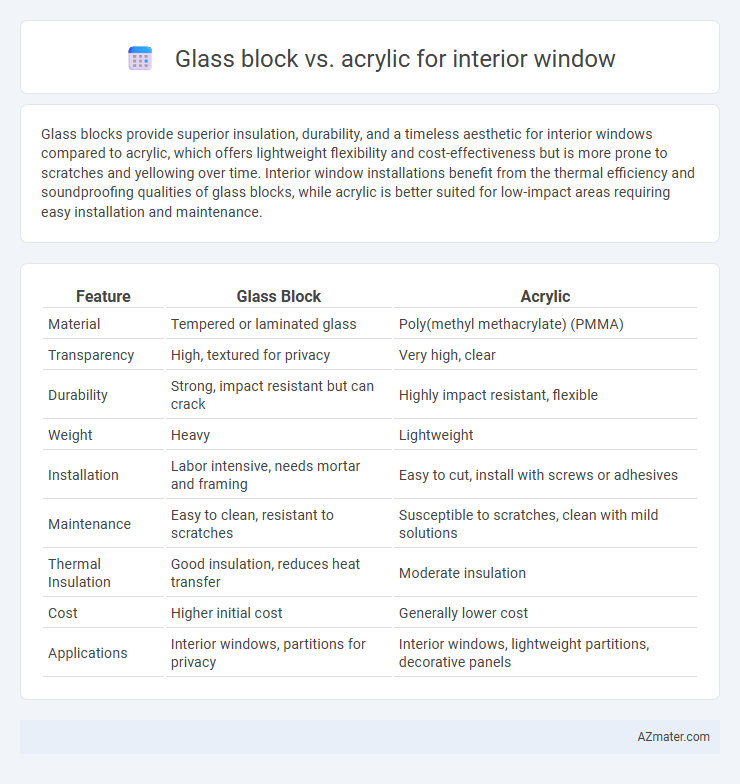Glass blocks provide superior insulation, durability, and a timeless aesthetic for interior windows compared to acrylic, which offers lightweight flexibility and cost-effectiveness but is more prone to scratches and yellowing over time. Interior window installations benefit from the thermal efficiency and soundproofing qualities of glass blocks, while acrylic is better suited for low-impact areas requiring easy installation and maintenance.
Table of Comparison
| Feature | Glass Block | Acrylic |
|---|---|---|
| Material | Tempered or laminated glass | Poly(methyl methacrylate) (PMMA) |
| Transparency | High, textured for privacy | Very high, clear |
| Durability | Strong, impact resistant but can crack | Highly impact resistant, flexible |
| Weight | Heavy | Lightweight |
| Installation | Labor intensive, needs mortar and framing | Easy to cut, install with screws or adhesives |
| Maintenance | Easy to clean, resistant to scratches | Susceptible to scratches, clean with mild solutions |
| Thermal Insulation | Good insulation, reduces heat transfer | Moderate insulation |
| Cost | Higher initial cost | Generally lower cost |
| Applications | Interior windows, partitions for privacy | Interior windows, lightweight partitions, decorative panels |
Introduction: Choosing Between Glass Block and Acrylic Windows
Glass block windows offer superior durability, thermal insulation, and privacy, making them ideal for interior spaces requiring both light diffusion and security. Acrylic windows provide lightweight flexibility, impact resistance, and ease of installation, suitable for budget-conscious projects needing quick updates. Evaluating factors such as maintenance, visual clarity, and acoustic performance helps determine the best fit for specific interior window applications.
Material Composition: Glass Block vs Acrylic
Glass blocks are made from solid, thick glass that provides excellent durability, sound insulation, and natural light diffusion, making them ideal for interior windows requiring privacy and strength. Acrylic panels consist of a lightweight, shatter-resistant plastic polymer known as polymethyl methacrylate (PMMA), offering superior impact resistance and easy customization but less inherent insulation and weightiness compared to glass blocks. Choosing between glass block and acrylic for interior windows depends on priorities such as material robustness, thermal properties, and design flexibility.
Aesthetic Appeal and Design Flexibility
Glass blocks offer a timeless, textured aesthetic that enhances natural light diffusion while providing privacy, making them ideal for classic or retro interior designs. Acrylic panels deliver superior design flexibility with customizable colors, shapes, and finishes, allowing for modern, sleek, and innovative interior window solutions. Both materials balance aesthetic appeal and functionality, but acrylic's lightweight and versatile properties enable more creative freedom in contemporary interior applications.
Light Transmission and Privacy
Glass blocks offer high light transmission with a natural, diffused glow that enhances privacy by obscuring clear views while allowing daylight to penetrate. Acrylic panels provide excellent clarity and greater light transmission but may compromise privacy unless frosted or treated with films. Selecting between glass block and acrylic depends on the balance needed between optimal daylight diffusion and desired privacy levels in interior spaces.
Energy Efficiency and Insulation Performance
Glass blocks offer superior thermal insulation due to their thick, solid composition and inherent thermal mass, reducing heat transfer more effectively than acrylic panels. Acrylic, while lightweight and impact-resistant, generally provides lower insulation performance and higher thermal conductivity, leading to increased energy loss. Choosing glass blocks for interior windows enhances energy efficiency by maintaining stable indoor temperatures and minimizing heating and cooling costs.
Strength, Durability, and Impact Resistance
Glass blocks provide superior strength and durability for interior windows due to their thick, solid construction, making them highly resistant to scratches and weathering. Acrylic offers excellent impact resistance and flexibility, reducing the risk of cracking or shattering under force, but it tends to scratch more easily compared to glass blocks. For long-term performance in high-impact environments, glass blocks maintain structural integrity better, while acrylic is preferred for lightweight, impact-resistant installations.
Installation Process and Ease of Maintenance
Glass blocks require professional installation due to their weight and need for precise mortar joints, ensuring durability and structural integrity, whereas acrylic panels are lightweight and can be easily cut and installed by DIY enthusiasts using standard tools. Maintenance of glass blocks involves periodic cleaning with non-abrasive solutions to prevent grime buildup without scratching, while acrylic surfaces demand frequent wiping to avoid scratches and may require specialized cleaners to maintain clarity. The installation complexity of glass blocks typically results in longer project timelines compared to the straightforward mounting of acrylic panels, influencing overall labor costs and maintenance routines.
Cost Comparison: Upfront and Long-Term Expenses
Glass blocks typically have a higher upfront cost compared to acrylic panels due to materials and installation complexity, but they offer greater durability and longevity, reducing long-term maintenance expenses. Acrylic windows are more budget-friendly initially, with easier installation and lower replacement costs, but they may require more frequent repairs or replacements over time because of susceptibility to scratches and discoloration. Choosing between glass block and acrylic depends on balancing initial investment with expected maintenance costs and lifespan for interior window applications.
Best Applications for Glass Block and Acrylic Windows
Glass block excels in interior windows where privacy, light diffusion, and enhanced security are priorities, making it ideal for bathrooms, stairwells, and office partitions. Acrylic windows offer superior clarity, impact resistance, and lightweight flexibility, suited for areas requiring unobstructed views and easy installation, such as skylights, conservatories, and creative architectural features. Choosing between glass block and acrylic depends on the specific benefits needed: glass block for durability and texture, acrylic for transparency and versatility.
Conclusion: Which is Better for Your Interior Space?
Glass blocks offer superior durability, natural light diffusion, and enhanced privacy, making them ideal for interior windows in spaces requiring both style and security. Acrylic panels provide lightweight flexibility and easier installation with greater impact resistance, suited for areas prioritizing cost-effectiveness and design adaptability. Choosing between glass block and acrylic depends on balancing long-term strength and visual appeal against budget and ease of maintenance for your interior space.

Infographic: Glass block vs Acrylic for Interior window
 azmater.com
azmater.com